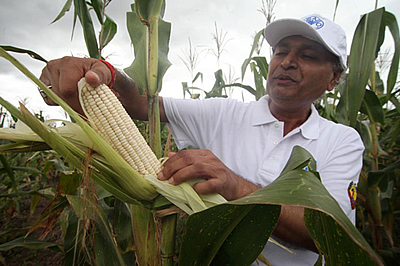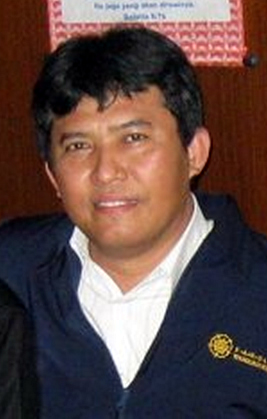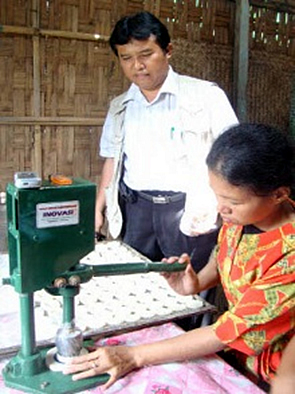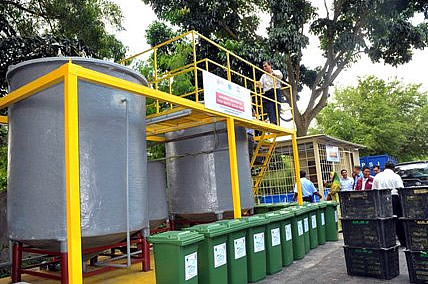- Details
- Category: 2012

In accord with one of the world's largest seed companies, UQ's Queensland Alliance for Agriculture and Food Innovation (QAAFI) has bolstered up its ever increasing reputation for high-impact science by co-developing innovative new crop technology.

Prof. Graeme Hammer, director of QAAFI's Centre for Plant Science, with the international seed company Pioneer Hi-Bred, a DuPont business, is leading a team of UQ scientists to develop a world-class computer model that assists farmers and scientists to better predict crop yields.
The work uses the Agricultural Production Systems Simulator (APSIM) software platform, developed in Australia through collaboration of CSIRO, the Queensland Government, and the University of Queensland.
The advancement of the maize crop modelling capability in APSIM with Pioneer has ushered in fast-tracking more effective breeding of drought-tolerant hybrids. This ultimately means that growers worldwide will be better able to meet the increasing demands on agricultural productivity.
With this platform, researchers are able to input many specific characteristics on how experimental plants behave under test conditions, and facilitates prediction of those few that will respond best under drought conditions in the field.
The state-of-the-art modelling capability integrates the latest understanding of crop reactions to drought.
Recently joining a European Commission-sponsored research consortium on DROught-Tolerant Plants (DROPS) are UQ and Pioneer, who has contributed their expertise and state-of-the-art modelling platform for use by the consortium. To improve drought-tolerance research in maize and other crop plants, DROPS is starting to develop novel tools and breeding strategies.
"Pioneer and UQ scientists will work together with consortium scientists to improve the modelling platform so that it can accept even more traits, thereby increasing the utility of the platform,"Prof. Hammer said.
"Members of the consortium will then have access to the resulting advanced modelling platform to facilitate their further drought research in a number of crops."
Prof. Hammer's research, its focus being the water productivity in cereals, is about the physiology and genetics of complex adaptive traits in field crops. This supports the development of mathematical models of crop growth, development and yield that allow simulation of consequences of genetic and management manipulation of crops in specific target environments. His research capabilities are focused on the major cereal crops: sorghum, maize and wheat.
He works together with plant breeders, geneticists, molecular biologists and agronomists in a range of national and international research projects in both public and private sectors.
Media: Professor Graeme Hammer
Director
Centre for Plant Science
Queensland Alliance for Agriculture and Food Innovation
g.hammer@uq.edu.au
QAAFI Communications
Ron Hohenhaus
r.hohen@uq.edu.au
0417 425 510
SOURCE: UQ News| 7 February 2012
- Details
- Category: 2012
Rengginang is a favorite traditional glutinous rice cracker snack in Indonesia. The production of this snack using a special machine operated manually requires time and patience resulting inlow production output.

Ir. Priyanto Triwitono, a lecturer of the Department of Agricultural Products Technology, Universitas Gadjah Mada (UGM), was motivated to improve the efficiency and productivity of rengginangby developing a rengginang maker.
The rengginang machine developed by Mr. Triwitono is capable of producing up to two times more rengginang than the manual process. He said that the machine produces 4-5 pieces of rengginang per minute or about 240-300 per hour as compared to 2 pieces per minute or 120 pieces per hour manually. "The capacity of the machine is at least 50 kg per day. With this machine, one kilogram of steamed glutinous rice can produce approximately 110-120 pieces of rengginang,"Mr.Triwitono said.
The machine is quite practical and can be operated by anyone, including beginners or non-experts. It is able to make rengginangs with exactly the same size, specifications and texture. Mr. Triwitono explained that his machine provides the same amount of pressure regardless of the operator so the rengginang is more solid, not easily broken and retains its shape.

The machine is operated without electricity or fuel, making it cost efficient. According to Mr. Triwitono, the working principle of the machine is adopted from that of a bottle lid. He explained that this device consists of a body/frame made of cast iron, the pole of the iron axle, wooden suppressor, ahandle to press the rengginang, atable holder, and a wooden press board containing hard pipe pieces.
He added that to make rengginangs using this machine, the following procedure should be followed: (1) Place the steamed glutinous rice into the pressing board;(2) Suppress/compact the rengginangby pulling down the handle; and (3) Remove the rengginangfrom the mold to dry. Mr. Triwitono said that he had developed different shapes of moldfor the rengginang such as circle, square, and rectangle.
This rengginang press has recently been mass-produced and is marketed at 2.5 million rupiah per machine.
SOURCE: UGM News|January 26, 2012
- Details
- Category: 2012

News about the outbreak of the tomcat beetle (Paederus fusipes) plaguing Surabaya, Madison, Pati, and Jakarta have spread all over Indonesia for a while now. The insect, which emits a strong poisonous liquid can cause severe itching and even blisters on the skin. However, that very same poisonous liquid is suspected to become a potent ingredient to help fight cancer.
According to Dr. Hidayat Purnama of the Department of Plant Protection, Faculty of Agriculture, Bogor Agricultural Institute (IPB), the tomcat beetle is a natural predator of the brown planthopper, which is considered one of the most serious rice pests in Asia. In a day, a single tomcat beetle can eat seven brown planthoppers. But aside from its significant role in sustainable agriculture, it has been found to contain pederin which, has the potential to fight cancer.
The recent tomcat outbreak in several communities in Indonesia may have been caused by the destruction of the insect's natural habitat. So that tomcat beetles will not invade your household, Dr. Purnama suggests reducing the number of lights used in the evening, instead of killing the insects.
Source: IPB News|12 April 2012
- Details
- Category: 2012

Universiti Putra Malaysia (UPM) teamed up with the Subang Jaya Municipal Council (MPSJ) to launch a Vermicomposting and Biogas Anaerobic Digestion technology that can help address the problem of solid waste in the Seri Serdang public market. According to MPSJ President Dato Asmawi Kasbi, this is the first green project undertaken by the local government. The National Solid Waste Management Department was able to provide MYR 200,000 for the Anaerobic Digestion Biogas component, while the Ministry of Education (MOE) covered the cost of the vermicomposting component of this technology developed by UPM researchers.
MPSJ expects local businesses as well as the residents of Serdang to benefit from this initiative.
The Anaerobic Digestion Biogas project has the capability to convert food waste into biogas. Anaerobic digestion of sludge from waste can also be used as fertilizer. Aside from good solid waste management practice, biogas technology is in line with Malaysia’s National Renewable Energy Policy and Action Plan which aims to increase the use of renewable energy for electricity from 1 percent to 5.5 percent by 2015.
On the other hand, vermicomposting refers to the natural decomposition process using vermin organisms (worms) to produce compost in 30 days. The vermicomposting project, led by Dr. Azni Idris of the Faculty of Engineering in UPM, aims to promote a green community and improve the quality of life in Serdang. The project is part of a three-year pilot program that intends to develop the concept of urban biomass.
Source: UPM News|23 April 2012
- Details
- Category: 2012

Prof. Dr. Pratikno, M.Soc.Sc., was elected Rector of Universitas Gadjah Mada for the period 2012-2017. After garnering the highest number of votes in the election, Pratikno expressed his appreciation for the trust given to him by the Board of Trustees who had elected him. He likewise extended his gratitude to the students who supported the election.
The former Dean of Faculty of Social and Political Sciences promised to monitor the democratization process in the university and work with the academic community in determining a policy and resolving a problem together. “A Rector would have no meaning if he cannot work in synergy with others,” he said.
Director General for Higher Learning, Djoko Santoso, representing the Minister for Education and Culture congratulated Pratikno and gave him the Minister’s message to carry out and uphold the mandate of UGM well.
“Universitas Gadjah Mada is a very special university for Indonesia. It has special significance in the Indonesian history of leadership since the beginning and until now,” Santoso said.
Pratikno gained his bachelor’s degree in Government Studies from UGM (1985), and was later accepted as lecturer at his Faculty. With his UGM affiliation, he was able to finish his master’s degree in development administration from University of Birmingham, UK (1991), and his doctorate from Flinders University, Australia (1997).
Source: UGM Daily News|01 April 2012






















